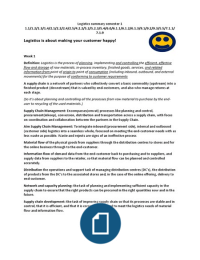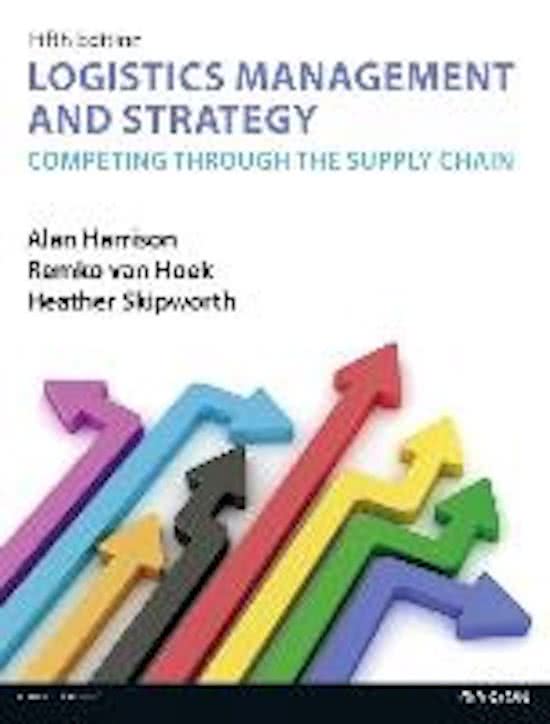Logistics summary semester 1
1.1/1.2/1.3/1.4/2.1/2.2/2.4/2.5/4.2.2/5.2/5.2.3/5.4/6.0/6.1.1/6.1.2/6.1.3/9.1/9.2/9.3/5.5/7.1.1/
7.1.9
Logistics is about making your customer happy!
Week 1
Definition: Logistics is the process of planning, implementing and controlling the efficient, effective
flow and storage of raw materials, in-process inventory, finished goods, services, and related
information from point of origin to point of consumption (including inbound, outbound, and external
movements) for the purpose of conforming to customer requirements
A supply chain is a network of partners who collectively convert a basic commodity (upstream) into a
finished product (downstream) that is valued by end-customers, and also who manage returns at
each stage.
(So it’s about planning and controlling all the processes from raw material to purchase by the end-
user to recycling of the used materials.)
Supply Chain Management: Encompasses(omvat) processes like planning and control,
procurement(inkoop), conversion, distribution and transportation across a supply chain, with focus
on coordination and collaboration between the partners in the Supply Chain.
Aim Supply Chain Management: To integrate inbound (procurement side), internal and outbound
(customer side) logistics into a seamless whole, focussed on meeting the end-customer needs with as
less waste as possible. Waste and rejects are signs of an ineffective process
Material flow of the physical goods from suppliers through the distribution centres to stores and for
the online business through to the end-customer.
Information flow of demand data from the end-customer back to purchasing and to suppliers, and
supply data from suppliers to the retailer, so that material flow can be planned and controlled
accurately.
Distribution the operations and support task of managing distribution centres (DC’s), the distribution
of products from the DC’s to the associated stores and, in the case of the online offering, delivery to
end-customer.
Network and capacity planning: the task of planning and implementing sufficient capacity in the
supply chain to ensure that the right products can be procured in the right quantities now and in the
future.
Supply chain development: the task of improving supply chain so that its processes are stable and in
control, that it is efficient, and that it is correctly structured to meet the logistics needs of material
flow and information flow.
,Supply chain: structure and tiering
Reverse logistics: the return of unwanted goods and packaging in the opposite direction (right to
left) to the normal flow.
Waste: the discarding of product at any stage in the supply chain due to quality problems.
Purchasing and supply deals with a focal firm’s immediate suppliers (upstream).
Physical distribution: the task of distributing products to tier 1 customers(downstream).
Logistics refers to management of materials and information flows. Inbound logistics deasl with links
between the focal firm and its upstream suppliers, whilst outbound logistics refers to the links
between the focal firm and its downstream customers. Internal logistics deals with planning and
control of material flow within the boundaries of the focal firm.
Flow measures the quantity of material (measured in input terms such as numbers of components,
tonnes or litres) that passes through a given network per unit of time.
Production or assembly process
What goes in, is different from what comes out (it is physically changed)
Storage or warehouse
what goes in, comes out physically unchanged
Physical flow
Information flow
All parts of the chain should be aware of and focused on the Final customer
,Supply chain Flow, a network
FINANCIAL PRODUCT
LOGISTICS
ADMINISTRATION DEVELOPMENT
MARKETING INFORMATION
MANAGEMENT
TECHNICAL STAFF
DEPARTMENT MANAGEMENT
The logistics department is related to all other departments in an organization
Lo – FA: logistics operations has to be as efficient as possible. F.I. Low average inventory means less
capital invested in stock levels so less inventory costs resulting in higher profitability
MA – LO: logistics assignment is to deliver the promised product or service on time, in the right
quality, at the right place , in the right numbers
TD – LO: technical support is very important in nowadays logistics operations in DC’s where we have
a lot of forklift trucks, sorting machines, Electronic Data Interchange (EDI)
PD - LO: PD and LO need to communicate with each other because new products need to fit within
the measurements of the crates used, the pallet sizes, the sorting band, availability of the materials
aso
IM – LO: EDI, Electronic Point Of Sale (EPOS) are crucial in nowadays logistics processes
,Porter’s Values chain
If a certain activity doesn’t add value you can leave out this activity.
Week 2
Competing trough logistics
Order winners: Factors that are key reasons for buying the product or service. Improving these
increases the chance of winning the order.
Order qualifiers: Factors that are regarded as a ‘minimum entry ticket’, the product or service has at
least to meet these basic performance standards.
Hard objectives:
Quality advantage; right article, right place, right numbers, right quality, on time
Time advantage; fast delivery may be an order winner (ecommerce, same day delivery)
Cost advantage. Lower prices and higher margins
Soft objectives:
Perceived values, often non-tangible:
Confidence in the company
Security (information is handled in a secure manner)
Brand image.
Logistics strategy is the set of guiding principles, driving forces and ingrained attitudes that help to
coordinate goals, plans and policies, and which are reinforced through conscious and subconscious
behavior within and between partners across a network
, Four options for crafting(bewerken) strategy
Several possible strategy goals: getting a larger market share, higher turn over, making product or
service more custom made
Evolve: our strategy is not to have a strategy, operating decisions are taken in relation to the needs
of the moment, with financial goals as the main guiding principle. Selling price > costprice
Classical: financial goals are achieved through a formal planning process. This is the oldest influential
option
Accommodate: decisions are made on day-to-day basis and accommodated to the realities of the
focal firm in which it operates
Systemic: goal setting takes place in all major aspects of the business and are linked to the means by
which they will be achieved in practice
Unique value proposition: determining what makes the product/service different from its
competitors.
Tailored supply chain: governed by consistent order winning and qualifying criteria.
Identify the trade-offs: by choosing not just the priorities but also what not to do;
A supply chain in which the links are directed towards the same competitive objectives will be able
to serve the end-customer better than supply chains who aren’t.
Links in a SC need to have a common and consistent set of competitive criteria.
This is the concept of focus. Focus is based on the view that you cannot be good at everything
For example: high volume and low cost does not match with high variety and flexibility
Align logistics processes: so that processes are mutually reinforcing






